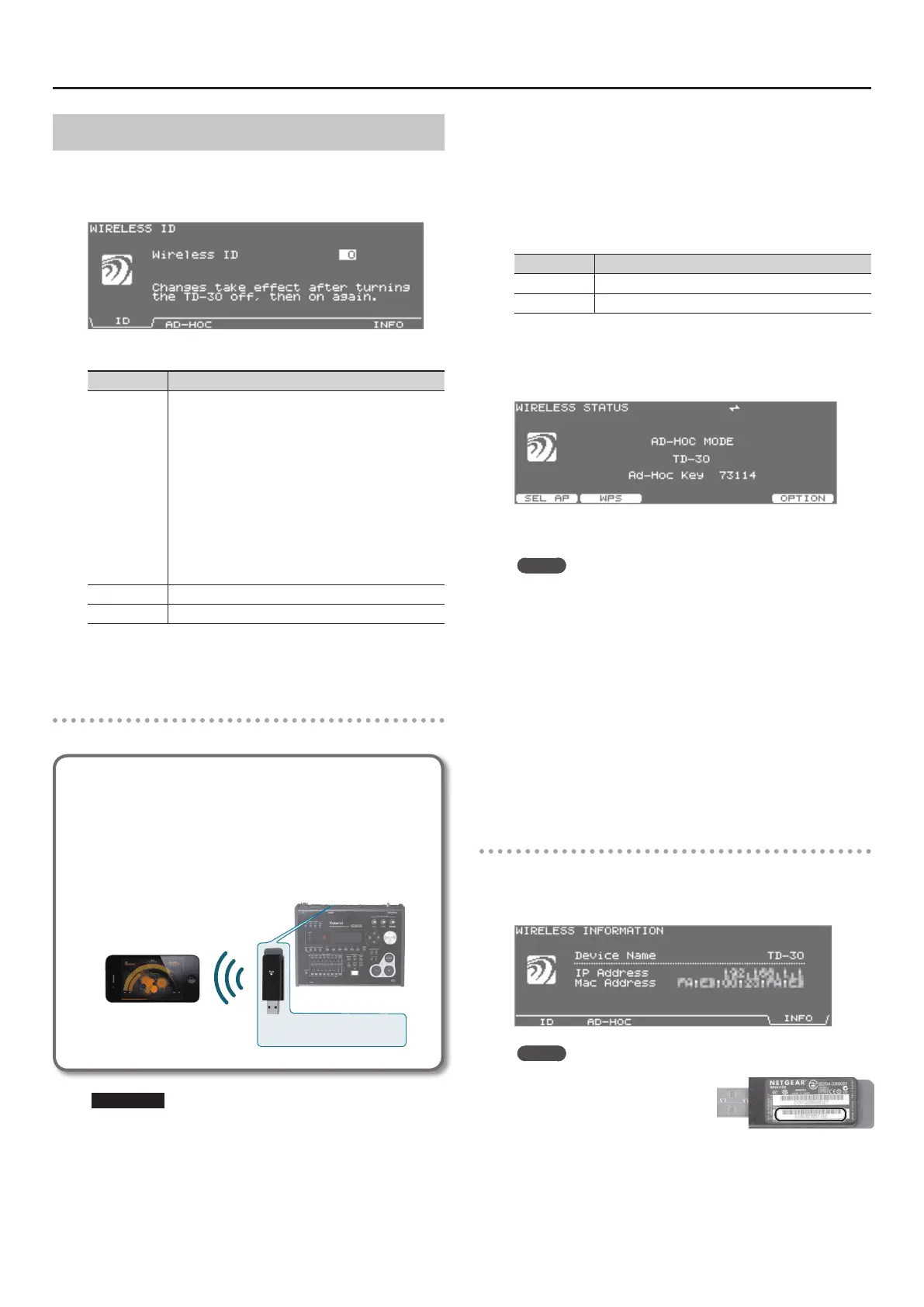About the Wireless LAN Function
3
Other Settings (WIRELESS OPTION)
Make settings for Wireless ID or Ad-Hoc mode.
1. Press the [SETUP] g [F5] (A>B>C) g [F5] (A>B>C) g
[F3] (WIRELES) g [F5] (OPTION) button.
What the function buttons do
Button Explanation
[F1] (ID)
Make setting for Wireless ID.
Species the nal digits of the
TD-30
’s device name and
Ad-Hoc SSID (TD-30) that will be shown as the instrument in
the wirelessly connected app.
Normally, you should specify “0,” but if you have more than
one of the same instrument, you can set the Wireless ID in
the range of 1–99 to change the device name and Ad-Hoc
SSID for each instrument, as follows.
If Wireless ID=0, “TD-30” (default value)
If Wireless ID=1, “TD-30-1”
:
If Wireless ID=99, “TD-30-99”
[F2] (AD-HOC) Make settings for Ad-Hoc mode.
[F5] (INFO) View the device name, IP address and MAC address.
* These settings will take eect after you’ve turned the unit o,
then back on again.
Connecting in Ad-Hoc mode (AD-HOC)
Here’s how to connect in Ad-Hoc mode.
What is Ad-Hoc mode?
Ad-Hoc mode lets you connect the TD-30 directly to an iPhone
or other wireless device without using a wireless LAN access
point. This is a convenient way to use the TD-30 with an
iPhone or other wireless device if you’re in a location where
the wireless LAN access point you normally use is unavailable,
such as when you’re away from home.
TD-30
Wireless USB Adapter (sold
separately: WNA1100-RL)
Wireless LAN
iPhone etc.
Limitations
The iPod touch or other wireless device connected in Ad-Hoc
mode will be unable to communicate with the Internet or with
another wireless device. However, an iPhone or other wireless
device that has cellular capability will be able to connect to the
Internet via the cellular connection.
Please be aware that if you use a cellular connection for Internet
connectivity, you may incur costs depending on your rate plan.
1. Press the [SETUP] g [F5] (A>B>C) g [F5] (A>B>C) g
[F3] (WIRELES) g [F5] (OPTION) g [F2] (AD-HOC) button.
The AD-HOC MODE SETTINGS screen will appear.
2. Turn the Ad-Hoc Mode “ON.”
You can use Channel to specify a channel (1–11) for Ad-Hoc mode.
Normally, you won’t need to change the channel. Try changing the
channel only if you have problems connecting.
Parameter Explanation
Ad-Hoc Mode Turns Ad-Hoc mode on/o.
Channel Species the channel (1–11) for Ad-Hoc mode.
3. Turn the unit o, then on again.
4. Press the [SETUP] g [F5] (A>B>C) g [F5] (A>B>C) g [F3]
(WIRELES) button to access the WIRELESS STATUS screen.
The Ad-Hoc SSID (TD-30) and the Ad-Hoc Key (a ve-character text
string) will be displayed.
MEMO
The Ad-Hoc SSID (TD-30) will be the value that you specied in
the WIRELESS ID screen “Wireless ID” setting.
5. On the iPhone or other wireless device that you want to
connect, select the Ad-Hoc SSID shown in the above screen
to make the connection. (For example, on an iPhone,
choose [Settings] g [Wi-Fi] g [Choose a Network] to select
the above Ad-Hoc SSID. A password entry screen will
appear; enter the above Ad-Hoc key.)
For details on how to connect to a wireless LAN from an iPhone or
other device, refer to the owner’s manual of that device.
6. When you want to end the Ad-Hoc mode connection,
restore the iPhone settings in [Settings] g [Wi-Fi] g
[Choose a Network] to their previous state.
Checking the IP Address and MAC Address (INFO)
Here’s how to check the IP address and MAC address.
1. Press the [SETUP] g [F5] (A>B>C) g [F5] (A>B>C) g
[F3] (WIRELES) g [F5] (OPTION) g [F5] (INFO) button.
MEMO
The MAC address shows the value
indicated on the bottom of the
wireless USB adapter (WNA1100-
RL; sold separately).
